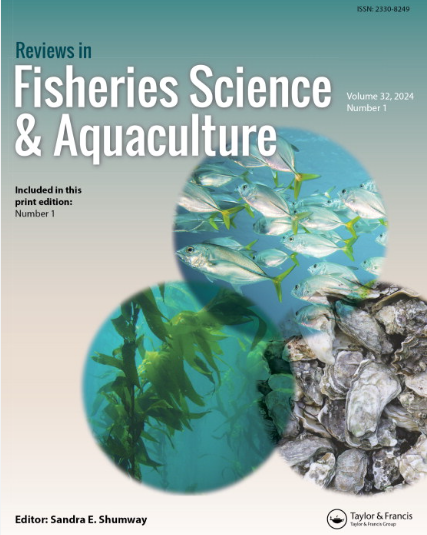The Decline and Impending Collapse of the Atlantic Salmon (Salmo salar) Population in the North Atlantic Ocean: A Review of Possible Causes
IF 5.3
1区 农林科学
Q1 FISHERIES
引用次数: 27
Abstract
Abstract Adult returns to many Atlantic salmon wild and hatchery stocks of the North Atlantic have declined or collapsed since 1985. Enhancement, commercial fishery closures, and angling restrictions have failed to halt the decline. Human impacts such as dams, pollution or marine overexploitation were responsible for some stock declines in the past, but adult returns to river and hatchery stocks with no obvious local impacts have also declined or collapsed since 1985. Multiple studies have postulated that the recent widespread occurrence of low adult returns may be caused by climate change, salmon farming, food availability at sea, or marine predators but these possibilities are unsupported by stocks that persist near historic levels, loss of stocks remote from farm sites, a diverse marine prey field, and scarcity of large offshore predators. The decline and collapse of stocks has common characteristics: 1) cyclic annual adult returns cease, 2) annual adult returns flatline, 3) adult mean size declines, and 4) stock collapses occurred earliest among watersheds distant from the North Atlantic Sub-polar Gyre (NASpG). Cyclic annual adult returns were common to all stocks in the past that were not impacted by anthropogenic changes to their natal streams. A flatline of adult abundance and reduction in adult mean size are common characteristics of many overexploited fish stocks and suggest illegal, unreported, and unregulated (IUU) fisheries exploitation at sea. Distance from the NASpG causing higher mortality of migrating post-smolts would increase the potential for collapse of these stocks from IUU exploitation. By-catch of post-smolts and adults in paired-trawl fisheries off Europe and intercept adult fisheries off Greenland, in the Gulf of St. Lawrence, and off Europe have been sources of marine mortality but seem unlikely to be the primary cause of the decline. Distribution in time and space of former, legal high-sea fisheries indicated fishers were well acquainted with the ocean migratory pattern of salmon and combined with lack of surveillance since 1985 outside Exclusive Economic Zones or in remote northern regions may mean high at-sea mortality occurs because of IUU fisheries. The problem of IUU ocean fisheries is acute, has collapsed numerous stocks of desired species worldwide, and is probably linked to the decline and impending collapse of the North Atlantic salmon population.北大西洋大西洋鲑鱼(Salmo salar)种群数量的下降和即将崩溃:可能原因的回顾
摘要自1985年以来,许多北大西洋野生鲑鱼和孵化场种群的成年回报率一直在下降或崩溃。渔业的加强、商业渔业的关闭和捕鱼限制都未能阻止这种下降。水坝、污染或海洋过度开发等人类影响是过去一些种群减少的原因,但自1985年以来,对河流和孵化场种群没有明显局部影响的成年回报率也有所下降或崩溃。多项研究假设,最近普遍出现的低成年回报率可能是由气候变化、鲑鱼养殖、海上食物供应或海洋捕食者引起的,但这些可能性没有得到持续接近历史水平的种群、远离农场的种群损失、多样化的海洋猎物场以及大型近海捕食者稀缺的支持。股票的下跌和崩溃有一个共同的特征:1)周期性的成年年回报停止,2)成年年回报持平,3)成年平均规模下降,4)股票崩溃最早发生在远离北大西洋次极地环流(NASpG)的流域。成年周期性年回报率在过去所有未受出生流人为变化影响的种群中都很常见。成体丰度的平线和成体平均大小的减少是许多过度开发鱼类种群的共同特征,表明在海上进行非法、未报告和无管制的渔业开采。与NASpG的距离会导致迁移后窒息的死亡率更高,这将增加这些种群因IUU开采而崩溃的可能性。欧洲海域成对拖网捕鱼和格陵兰岛、圣劳伦斯湾和欧洲海域拦截成年渔业中的副渔获物是海洋死亡的来源,但似乎不太可能是死亡人数下降的主要原因。以前合法的公海渔业在时间和空间上的分布表明,渔民对鲑鱼的海洋迁徙模式非常熟悉,再加上自1985年以来在专属经济区外或偏远的北部地区缺乏监测,可能意味着由于非法、无管制和无管制捕鱼,海上死亡率很高。非法、无管制和未报告的海洋渔业问题十分严重,已经使世界各地大量所需物种的种群崩溃,这可能与北大西洋鲑鱼种群的减少和即将崩溃有关。
本文章由计算机程序翻译,如有差异,请以英文原文为准。
求助全文
约1分钟内获得全文
求助全文
来源期刊

Reviews in Fisheries Science & Aquaculture
FISHERIES-
CiteScore
25.20
自引率
0.90%
发文量
19
期刊介绍:
Reviews in Fisheries Science & Aquaculture provides an important forum for the publication of up-to-date reviews covering a broad range of subject areas including management, aquaculture, taxonomy, behavior, stock identification, genetics, nutrition, and physiology. Issues concerning finfish and aquatic invertebrates prized for their economic or recreational importance, their value as indicators of environmental health, or their natural beauty are addressed. An important resource that keeps you apprised of the latest changes in the field, each issue of Reviews in Fisheries Science & Aquaculture presents useful information to fisheries and aquaculture scientists in academia, state and federal natural resources agencies, and the private sector.
 求助内容:
求助内容: 应助结果提醒方式:
应助结果提醒方式:


